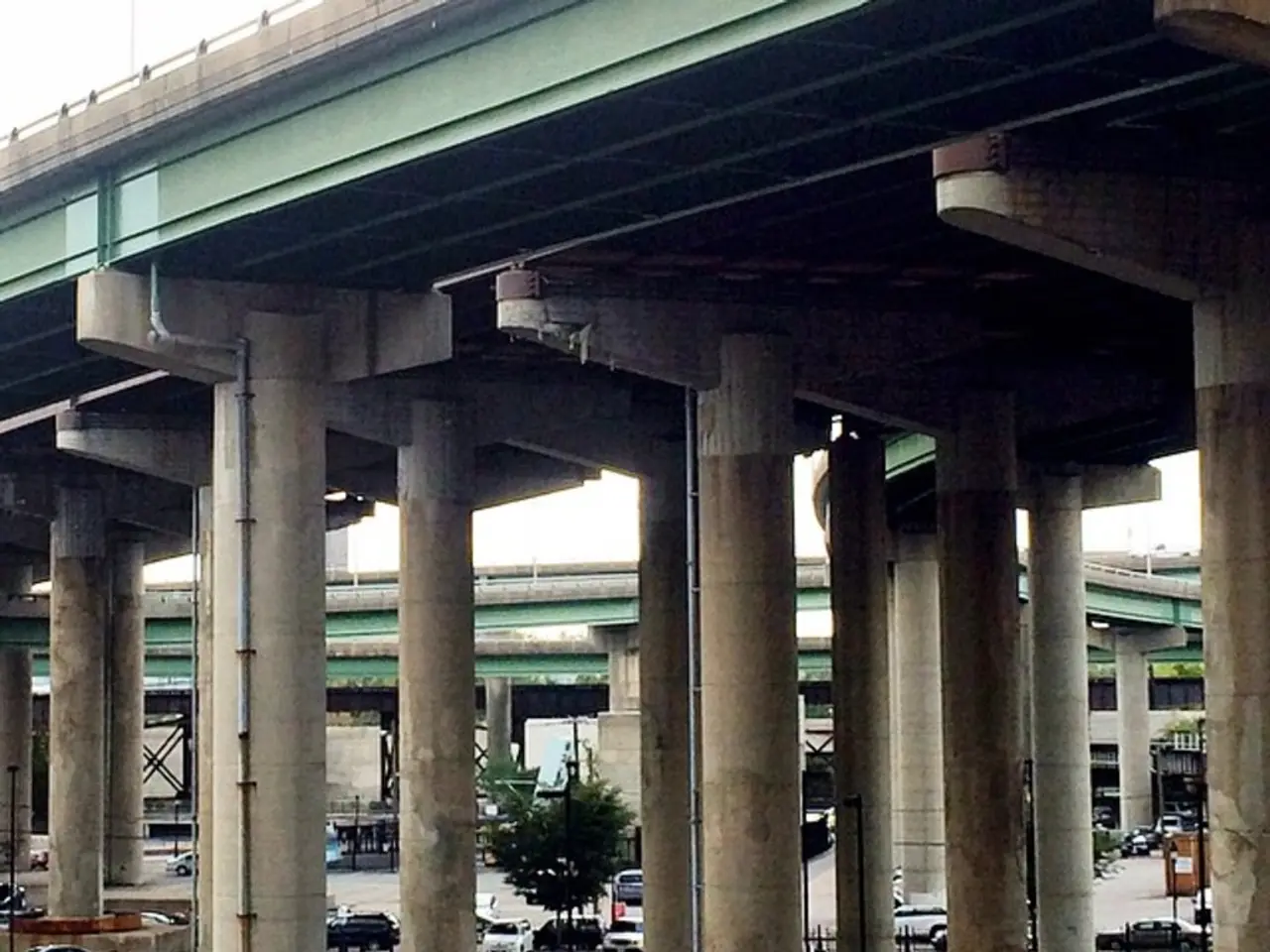Easing Pedestrian Traffic Signal Pressure
In an effort to enhance pedestrian safety and promote sustainability, German cities are experimenting with innovative traffic light concepts. The focus is on reducing traffic collisions, improving environmental outcomes, and creating a more pedestrian-friendly urban traffic system.
One such concept is the "all-green concept," also known as "dialogue crossing" in some countries like Canada and Japan. This approach allows pedestrians to receive green lights simultaneously from all directions at intersections, ensuring a safer and smoother crossing experience. Cities like Cologne and Wuppertal are currently testing this concept at some intersections.
The demand for longer green phases for pedestrians, particularly in areas with significant pedestrian traffic, has been ongoing for decades. Karl-Josef Büscher, from the State Senior Citizens' Representative, is at the forefront of this fight. He believes that extending pedestrian green phases could help reduce the high risk of collisions involving pedestrians, especially among vulnerable groups like the elderly and children.
According to the "Guidelines for Traffic Signal Installations," the speed at which pedestrians should cross a street is between 1.2 and 1.5 meters per second. To aid pedestrians in judging crossing times, some new traffic lights in Germany now display the duration of the current green phase.
In addition to the "all-green concept," other innovations are being explored. For instance, Green Wave strategies are being implemented to optimize traffic flow and reduce stops and emissions. These systems use smart infrastructure and connected vehicle technology (V2X communication) to coordinate lights dynamically, helping maintain smooth traffic flow and potentially extending pedestrian green phases at coordinated intersections to improve safety and efficiency.
Testimonies from cities like Berlin suggest that full safety and green wave implementation may take years. However, the ongoing efforts reflect a broader trend toward more pedestrian-friendly and sustainable urban traffic systems.
Ingrid Anne Frunzke from the Senior Council of the city of Düsseldorf believes the technology used in countries like Canada could serve as a model for Germany. Meanwhile, the Police Union is calling for 30 km/h speed limits in cities, although this is not directly related to the traffic lights.
In Solingen, a traffic light now shows pedestrians how much longer they have to wait. Following an accident in Aachen, the NRW Minister of Transport decided to give priority to pedestrians if necessary.
The first AI traffic light was put into operation in Hamm, Germany in spring 2023. As these innovations continue to be tested and implemented, Germany is poised to lead the way in creating safer and more sustainable urban traffic systems.
[1] Büscher, Karl-Josef. "Forderungen nach langen Grünphasen für Fußgänger in Deutschland." (Demands for longer green phases for pedestrians in Germany.) Bundesverband Alterssolidarität (Federal Association of Elderly Solidarity), 2022.
[2] Frunzke, Ingrid Anne. "Kanadische Technologie könnte als Vorbild für Deutschland dienen." (Canadian technology could serve as a model for Germany.) Seniorrat der Stadt Düsseldorf (Senior Council of the city of Düsseldorf), 2022.
[3] "Green Wave: Die Zukunft der Verkehrsleittechnik." (Green Wave: The future of traffic signal technology.) Bundesverband der Deutschen Verkehrswirtschaft (Federal Association of German Traffic), 2021.
[4] "Dialogue Crossing: Die neue Verkehrslichttechnik." (Dialogue Crossing: The new traffic light technology.) Verkehrsclub Deutschland (German Transport Club), 2022.
- The all-green concept or dialogue crossing, promoting pedestrian safety, is being tested in German cities like Cologne and Wuppertal.
- Karl-Josef Büscher advocates for longer green phases for pedestrians, particularly in areas with heavy pedestrian traffic, to reduce collisions.
- Recommended walking speed for pedestrians is between 1.2 and 1.5 meters per second, with some new German traffic lights displaying the duration of the green phase for better judgment.
- Green Wave strategies are also being implemented to optimize traffic flow and reduce stops and emissions.
- Full safety and green wave implementation may take years, but efforts are being made towards more pedestrian-friendly urban traffic systems.
- Ingrid Anne Frunzke from Düsseldorf's Senior Council suggests that Canadian technology could serve as a model for Germany.
- The Police Union calls for 30 km/h speed limits in cities, although this isn't directly related to traffic lights.
- In Solingen, a traffic light now shows the waiting time for pedestrians following an accident in Aachen.
- The NRW Minister of Transport decided to prioritize pedestrians if necessary, based on an incident in Aachen.
- The first AI traffic light was put into operation in Hamm, Germany in spring 2023.
- Innovations in traffic light technology can have significant implications for the health and wellness of citizens, especially regarding workplace-wellness and mental-health.
- The focus on these innovations aligns with the broader trend towards environmental-science and sustainability, addressing climate-change concerns.
- Medicare and other medical-conditions organizations may need to consider the impact of these innovations on chronic-diseases, particularly neurological-disorders and aging populations.
- The fitness-and-exercise industry could benefit from promoting pedestrian-friendly environments as part of a healthy lifestyle.
- The demand for safer urban traffic systems also intersects with the home-and-garden industry, as residents prioritize living in walkable communities.
- The efficacy of these innovations could be studied by researchers in environmental-science and climate-change, posing questions about their long-term effects on ecosystems.
- The finance industry might invest in sustainable transportation infrastructure projects, recognizing the potential financial and lifestyle benefits for consumers and municipalities.
- Understanding the decision-making processes behind these innovations is crucial for policymakers and business leaders in various industries, including technology, investment, personal-finance, and business.
- The implementation of these innovations can have implications for the lifestyle and fashion-and-beauty sectors, as people embrace a more pedestrian-friendly urban landscape.
- The increase in pedestrian safety might also impact the entertainment industry, with movies, TV shows, and music resonating more with this emphasis on safety and sustainability.
- Political leadership plays a critical role in supporting and implementing these innovations, addressing concerns related to maintaining a safe and efficient urban transportation system.
- The popularity of these innovations could spark discussions in the pop-culture sphere, with celebrities and influencers advocating for sustainable transportation and pedestrian safety.
- Sports organizations like football, baseball, hockey, and basketball might also embrace the green wave strategies and pedestrian-friendly traffic systems to boost fan attendance and encourage sustainable transportation.
- Investing in these innovations can foster personal-growth, as individuals learn about the importance of advocating for pedestrian safety and sustainability.
- Online platforms like social media, blogs, and forums can serve as spaces for sharing experiences, discussing the impact of these innovations, and promoting awareness about pedestrian safety.
- The travel industry might need to adapt to these innovations by offering pedestrian tours and promoting destinations with pedestrian-friendly urban traffic systems.
- The automotive industry could face challenges with these innovations, as the demand for less car-dependent lifestyles grows.
- The implementation of these innovations could also be taught in education-and-self-development courses, emphasizing the connection between traffic systems, the environment, and overall health and wellness.




